Abstract
Today, the ways of working and doing business are changing form with developing technology. The recent COVID-19 pandemic has also accelerated this change. These developments have highlighted practices for conducting work remotely. Research on these practices, which can be generally expressed under the concept of telework, is developing in the business and management sciences literature about various disciplines. However, the governance of telework is still unexplored. For researchers who want to conduct research in this field, there are needs for studies to identify a general picture of the literature, trends, and research gaps. In this context, a bibliometric analysis of the governance of telework and related concepts in the business and management sciences literature in the Web of Science (WoS) database covering the period 2013-2023 was conducted. Using VOSviewer software, citation, co-citation, author keyword analysis, and co-authorship analysis were made, and the bibliometric mapping method was visualized. The results revealed that the governance of telework has not yet been adequately addressed. Despite recent studies on digitalization, technology, and innovation of telework, the research evidence is still scarce. Future studies on the function of telework within the firm management system, its relationship with strategies, resilience, and business continuity have the potential to contribute to the enrichment of this field.
Keywords: Bibliometric Analysis, Flexible Work, Remote Work, Telework, Telecommuting
Introduction
Today, technology has a rate of development that can be characterised as a geometric increase. As technological instruments such as artificial intelligence, the Internet of Things, and cloud computing affect people's daily lives. These developments also affect the business world on a path that extends to Industry 4.0 and beyond. A component of the business world, the way of doing business is one of the main elements affected by these developments. Organisations’ performance is commonly influenced by firms' characteristics and environment determinant factors (Romus et al., 2020). However, when technology evolves, ways of doing business, which can be characterised as classical styles, also change form and adapt to new developments. In addition, the COVID-19 pandemic, which affected the whole world between 2020 and 2022, has necessarily accelerated the change in ways of doing business. Due to the lockdowns implemented during this period, applications for conducting business remotely came to the fore.
Research on these practices, which can generally be expressed under the concept of telework, has increased in the literature of business and management sciences, especially in recent years. Research on telework is both related to various disciplines and distributed among the sub-branches of business and management sciences. This field, which more and more researchers are interested in, is expanding in the shadow of developing technology under the influence of turbulence such as crisis, disaster, and pandemics and concerning various disciplines. The research aims to present the distribution of the concept of telework in the business and management sciences literature in a collective framework and to analyse the trend changes in research areas in the last decade. This way, a guiding literature overview will be presented for researchers who want to research this field. To achieve these objectives, the bibliometric analysis method was preferred.
The bibliometric analysis method helps to develop a holistic understanding of the researched topic through methods such as direct citation, co-citation, author keyword and co-authorship analyses, and scientific mapping (Zan, 2019). The method allows for the quantification and analysis of the studies in the literature. The benefits of bibliometric analysis include obtaining an overview of the researched topic, identifying knowledge gaps, and enabling new research ideas, thanks to a holistic view (Donthu et al., 2021). In this way, trends can be revealed by exploring the knowledge structure in the field. From this point of view, this study presents a bibliometric analysis-based perspective on the business and management sciences literature studies in the 2013-2022 and first quarter of 2023.
Working Outside of the Workplace
As a form of work, working outside the workplace is developing in the shadow of developing technology and under the influence of turbulence such as crises, disasters, and pandemics. Various terms in the business and management sciences literature refer to this type of work. Although they have various differences, these terms used interchangeably in the literature can be listed as telework, flexible work, remote work, and telecommuting.
Flexible work refers to flexibility in terms of working time and workplace. The literature defines it as applying the standard working style of working five days a week and eight hours a day in different ways regarding the working place and working hours (Yorulmaz et al., 2023). The concept of flexible work includes the concepts of remote work and telework. These concepts are flexible work arrangements tools that allow organisations and employees to choose the amount, timing, or location of their work (De Menezes & Kelliher, 2017).
The concepts of remote work and telework, which are prominent in flexible working arrangements compared to other types of work (Contreras et al., 2020), refer to essentially the same kind of work but have differences (Yorulmaz, 2023). As an overarching umbrella concept, remote work refers to performing work wholly or partially at an alternative location other than the workplace (International Labour Organization, 2020). Telework is defined as work performance wholly or partly at an alternative location outside the workplace through information and communication technologies (International Labour Organization, 2020). While remote work means performing any work remotely, including physical work, where information and communication technologies are not required, telework emphasises performing work specifically through information and communication technologies.
While the concept of telework is preferred in Europe, the concept of telecommuting, which has the same meaning, is preferred in America (Dockery & Bawa, 2020), India, and Japan (Eurofound & International Labour Organization, 2017). Although they have differences, the concepts of telework, remote work, flexible work, and telecommuting are included in the scope of this research because they have common points and are often preferred interchangeably in the literature.
Methodology
In this research, the bibliometric analysis method, which is most suitable for the research objectives, scope, and the size of the literature under investigation, has been chosen. The bibliometric analysis method is useful when the research topic is addressed comprehensively, and it aims to make sense of large volumes of unstructured data to reveal the bibliometric and intellectual structure of the research field (Donthu et al., 2021). This method's benefits include offering a general overview of the research area, identifying research gaps, and deriving new research ideas related to these gaps.
Limited protocols exist that provide transparency and guidance for the application of bibliometric analysis, which is often confused by researchers with systematic reviews and meta-analyses. While the discussion of differences between these methods is beyond the scope of this article, authorised guidelines for systematic literature reviews (Snyder, 2019) or protocols such as Preferred Reporting Items for Systematic Reviews and Meta-Analysis (PRISMA) (Moher et al., 2015) are not specifically tailored to the bibliometric analysis method. Therefore, to ensure transparency in this research, The Bibliometric Analysis Procedure developed by Donthu et al. (2021) was followed to guide the application of the bibliometric analysis method. The steps of the method and applications in the context of this research are presented in Figure 1.
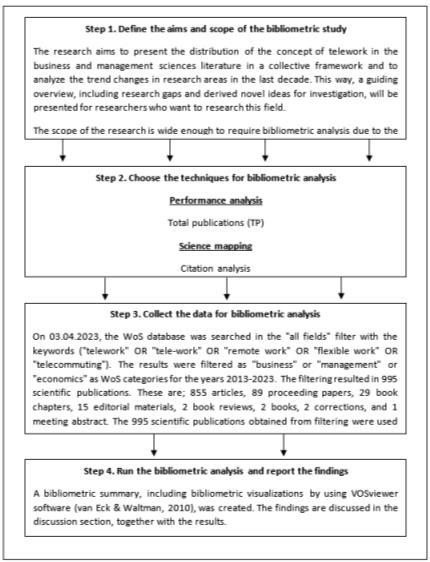
Findings
Descriptive Analyses
The numerical distribution of publications with the keywords ("" OR "" OR "" OR "" OR "") in the WoS database by year is given in Figure 2.
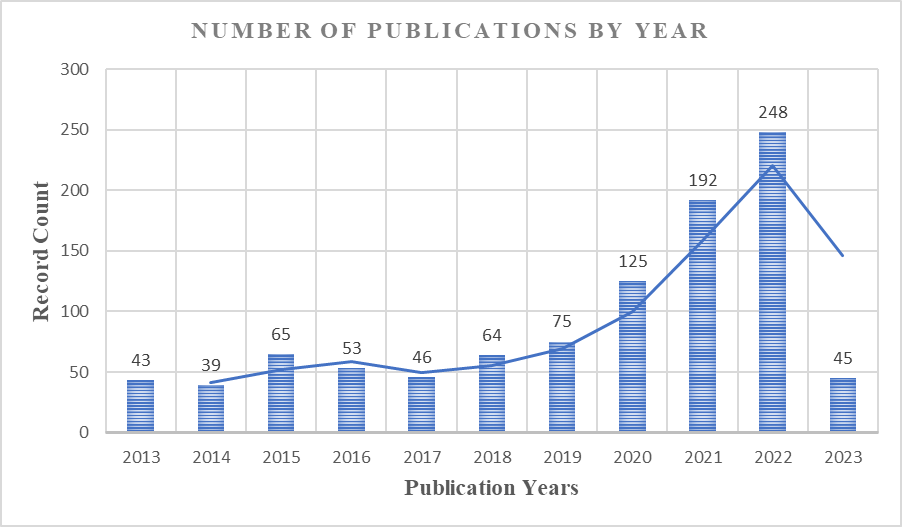
When Figure 2 is analyzed, it is seen that there has been a steady upward trend in publications since 2017. It is seen that this upward trend has accelerated since 2020 and peaked in 2022 with 248 publications. In the first quarter of 2023, there were 45 publications.
The distribution of publications by field is presented in Table 1. The table shows the ten categories with the highest distribution. This distribution shows that publications filtered as WoS categories ("" OR "" OR "") are associated with other categories. In other words, publications can be tagged with more than one category by WoS, and this simultaneous categorisation shows which other fields the publications are related to in parallel with ("" OR "" OR ""). This is important data in terms of showing research field trends.
When Table 1 is analysed, it is seen that most of the publications on the subject are in the "management" field. Publications in the field of "management" are more than the sum of publications in the fields of "economics" and "business." After these, "psychology applied" and "industrial relations labour" stand out as the most related fields. The results show that researchers mainly address the issue from the perspective of "psychology applied" and "industrial relations labour" about "management" or "economics", or "business".
Co-authorship of authors analysis
Co-authorship of authors analysis was conducted to identify the most cited researchers and the network relations between them. These data are essential for researchers interested in this topic as they show the authors who shaped the field in 2013-2023 and network relations.
The most cited authors on the subject are presented in Table 2, along with the number of citations and publications. Table 2 is limited to authors with 150 or more citations.
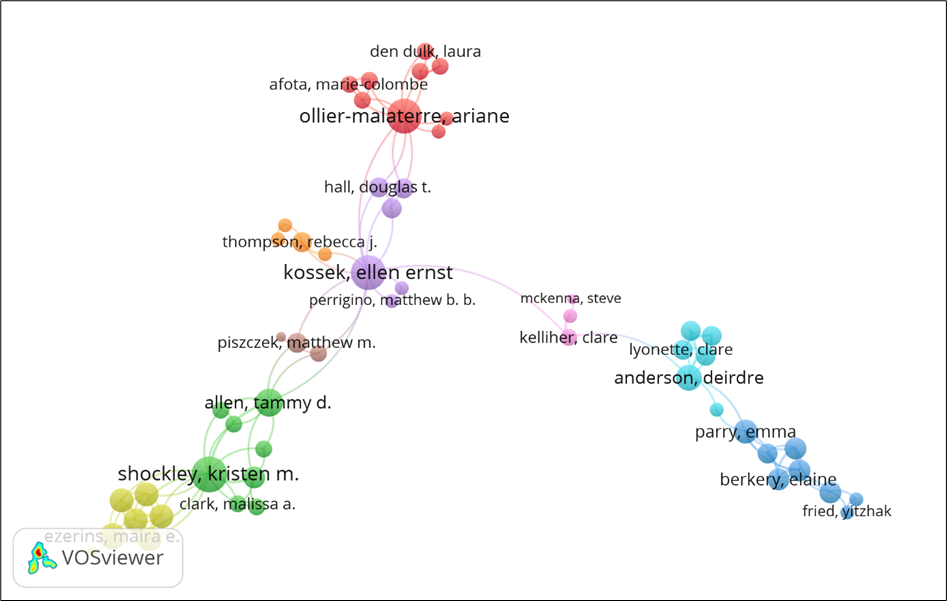
The network map resulting from the co-author analysis is presented in Figure 3.
As a result of the analysis, the network relationships are divided into nine layers symbolized by different colors.
Citation Analysis
Document-based citation analysis is presented in Table 3. The most cited documents are listed in the table according to the number of citations. The table is limited to the top five most cited publications.
Co-Citation Analysis
Co-citation analysis refers to cases where two different sources are cited simultaneously, and the high number of co-citations emphasizes the intensity of the relationship (van Eck, 2011). The network map for co-citation analysis is presented in Figure 4. To provide a clear understanding of the map, the map was delimited by applying the co-citation filter of fifty for the co-citations.
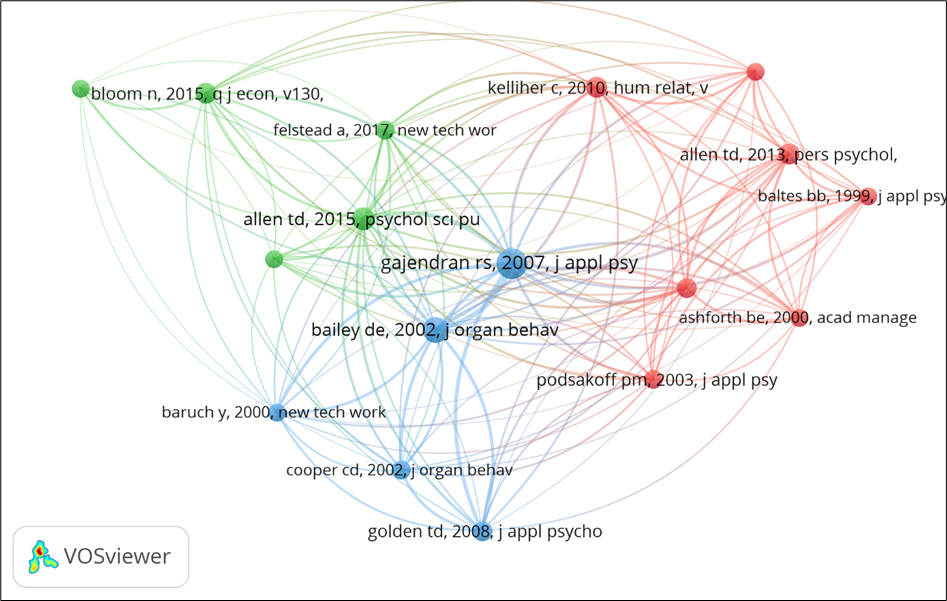
As a result of the analysis, network relationships are displayed in three layers symbolised by different colours.
Author Keyword Analysis
Keyword analysis analyses the co-occurrence of keywords used in publications. Co-occurrences of author keywords are presented in Table 4 had a delimited filter of nine co-occurrences.
To observe the current trends more closely, the relationships and distributions of keywords are presented in Figure 5 with a color scale by bibliometric mapping method for the last five years.
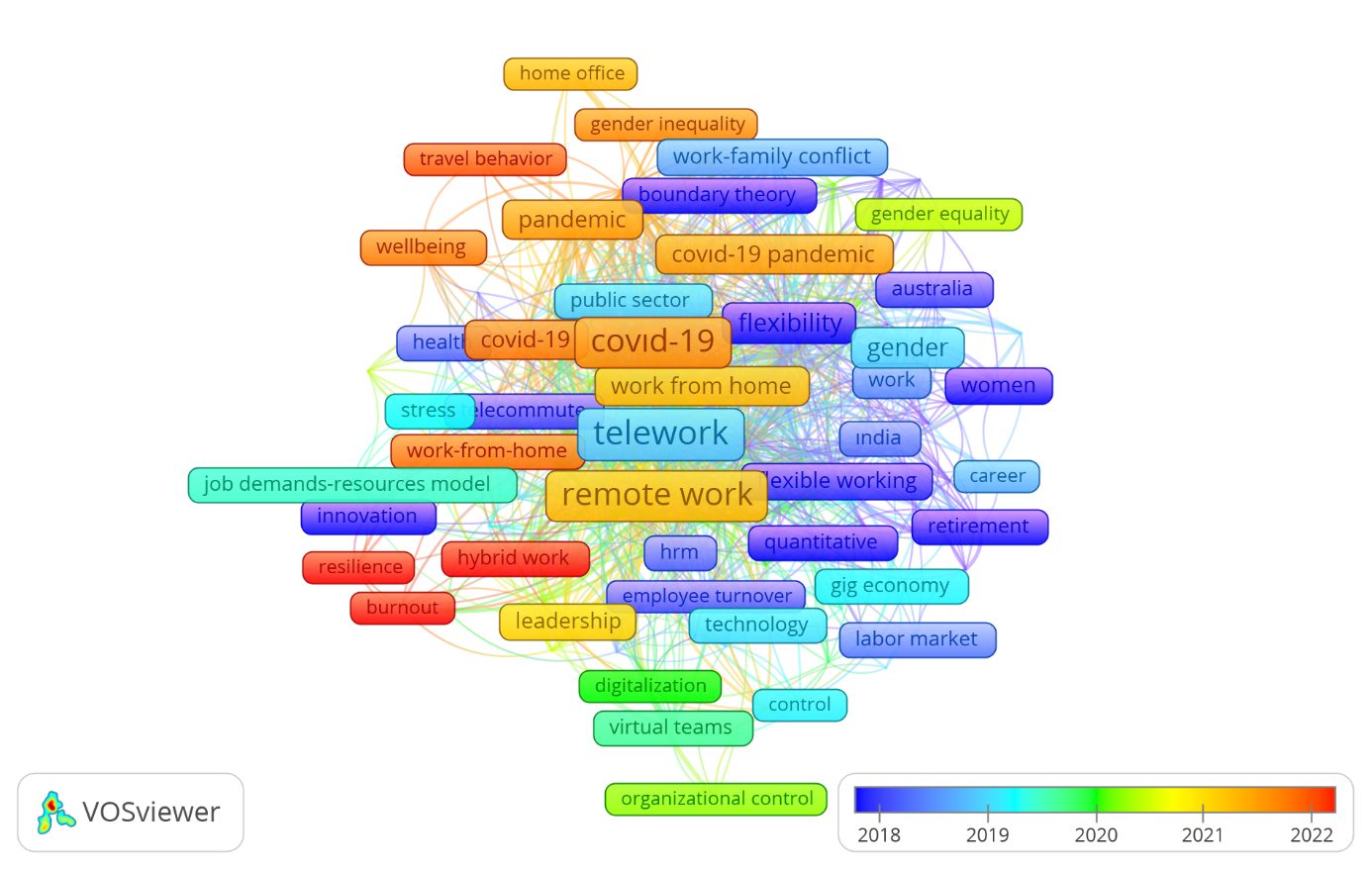
Keyword analysis revealed that the most used keywords are "telework", "remote work", "covid19", "telecommuting", and "work-life balance". Recent keywords are "resilience", "burnout", and "hybrid work".
When the co-occurrences of author keywords and the last five years' map are examined, some research questions can be asked open up new research areas on emerging trends. What kind of relationship can be mentioned between telework and organisational resilience? What are the telework application types, and are these types related to organisational resilience? What is the place of digitalization and innovation in telework applications? What kind of relationships exists between telework applications, hybrid work types, and firm performance from a human resource management perspective?
Conclusion, Discussion and Recommendations
This study aims to provide a general picture of the literature on working outside of the workplace, which has become prominent in the business and management sciences literature in recent years. This aims to inform and enlighten researchers who want to research in this field about the general state of the literature. The study has achieved its purpose with the analyses made. While the current state of the literature is depicted, the insights on research gaps contribute to the novel contribution to the field.
The results show that the steady upward trend of studies on the governance of telework in the literature had turned into an aggressive upward trend in 2020 and later years when the COVID-19 pandemic occurred. Therefore, it can be interpreted that working outside of the workplace is now an accepted practice in the business world and will continue to exist. The research areas that stand out in business and management are applied psychology, industrial relations, labour, and transportation. This shows that the research areas mostly emphasise the level of individual analysis and supply chain issues, which have become especially important during COVID-19.
In the keyword analysis, words such as "COVID-19", "work-life balance", "gender", "job satisfaction", "well-being", and "productivity" stand out. These results support the results that research in the field is conducted on individuals and at the individual analysis level. The words "burnout", "hybrid work", and "resilience", which have emerged recently, show that although this individual interest continues, the level of analysis has started to be addressed at the organizational level, especially with the subject of resilience. Based on the analyses, it can be concluded that the effects of governance of telework on individuals/employees are mostly investigated. However, the subject still needs to be sufficiently investigated at the organizational level, and there are deficiencies in this field. In addition, although the words "digitalization", "technology", and "innovation" are included in recent studies, keyword occurrences are low, and it can be inferred that there is a need for studies in the context of business and management sciences. In addition, studies on the functions of telework in the firm management system, its relationship with firm strategies, its relationship with firm resilience, and business continuity have the potential to contribute to the enrichment of this field.
However, this research has some limitations. The research was conducted on the WoS database. However, in future studies, the research can be expanded on other critical databases in social sciences. In this way, more detailed information about the trends in the field can be obtained. In future studies, in co-author and co-citation analyses, more detailed research by separating the relationships between studies and authors based on clusters can reveal author-subfield relationships and clarify the picture even more.
Acknowledgement
The authors are grateful to the Accounting Research Institute (ARI- HICoE), Universiti Teknologi MARA, Shah Alam, Malaysia, and the Ministry of Higher Education for funding research.
References
Allen, T. D., Johnson, R. C., Kiburz, K. M., & Shockley, K. M. (2013). Work–family conflict and flexible work arrangements: Deconstructing flexibility. Personnel Psychology, 66(2), 345-376. DOI:
Charalampous, M., Grant, C. A., Tramontano, C., & Michailidis, E. (2019). Systematically reviewing remote e-workers’ well-being at work: A multidimensional approach. European Journal of Work And Organizational Psychology, 28(1), 51-73. DOI:
Contreras, F., Baykal, E., & Abid, G. (2020). E-Leadership and Teleworking in Times of COVID-19 and Beyond: What We Know and Where Do We Go. Frontiers in Psychology, 11. DOI:
De Menezes, L. M., & Kelliher, C. (2017). Flexible Working, Individual Performance, and Employee Attitudes: Comparing Formal and Informal Arrangements. Human Resource Management, 56(6), 1051-1070. DOI:
Dingel, J. I., & Neiman, B. (2020). How many jobs can be done at home? Journal of Public Economics, 189, 104235. DOI:
Dockery, M., & Bawa, S. (2020). Working from home in the COVID-19 Lockdown. Bankwest Curtin Economics Centre Research Brief COVID-19, 1-5.
Donthu, N., Kumar, S., Mukherjee, D., Pandey, N., & Lim, W. M. (2021). How to conduct a bibliometric analysis: An overview and guidelines. Journal of Business Research, 133, 285-296. DOI:
Eurofound & International Labour Organization. (2017). Working anytime, anywhere: The effects on the world of work. Luxembourg: Office of the European Union and Geneva, CH: International Labour Office.
Felstead, A., & Henseke, G. (2017). Assessing the growth of remote working and its consequences for effort, well‐being and work‐life balance. New Technology, Work and Employment, 32(3), 195-212. DOI:
International Labour Organization. (2020). COVID-19: Guidance for labour statistics data collection; Defining and measuring remote work, telework, work at home and home-based work. Geneva, CH: International Labour Office.
Moher, D., Shamseer, L., Clarke, M., Ghersi, D., Liberati, A., Petticrew, M., Shekelle, P., & Stewart, L. A. (2015). Preferred reporting items for systematic review and meta-analysis protocols (PRISMA-P) 2015 statement. Systematic Reviews, 4(1). DOI:
Romus, M., Anita, R., Abdillah, M. R., & Zakaria, N. B. (2020). Selected Firms Environmental Variables: Macroeconomic Variables, Performance and Dividend Policy Analysis. IOP Conference Series: Earth and Environmental Science, 469(1), 012047. DOI:
Snyder, H. (2019). Literature review as a research methodology: An overview and guidelines. Journal of Business Research, 104, 333-339. DOI:
Spreitzer, G. M., Cameron, L., & Garrett, L. (2017). Alternative Work Arrangements: Two Images of the New World of Work. Annual Review of Organizational Psychology and Organizational Behavior, 4(1), 473-499. DOI: 10.1146/annurev-orgpsych-032516-113332
van Eck, N. J. (2011). Methodological advances in bibliometric mapping of science [Unpublished Doctoral dissertation]. Erasmus Research Institute of Management (ERIM).
van Eck, N. J., & Waltman, L. (2010). Software survey: VOSviewer, a computer program for bibliometric mapping. Scientometrics, 84(2), 523-538. DOI:
Yorulmaz, H. (2023). Dijital çağda KOBİ’lerde örgütsel dayanıklılık için stratejik yönelimler ve esnek çalışma model önerisi [Strategic orientations and telework model proposal for organizational resilience in SMEs in the digital era] [Unpublished Doctoral dissertation]. Istanbul Medipol University.
Yorulmaz, H., Baykal, E., & Eti, S. (2023). Effects of teleworking and strategic orientations on resilience in the post-pandemic period. OPUS Journal of Society Research, 20(51), 30-42. DOI:
Zan, B. U. (2019). Doğrudan atıf, ortak atıf ve bibliyografik eşleşme yaklaşımlarına dayalı olarak araştırma alanlarının değerlendirilmesi [Evolution of research subjects based on direct citation, co-citation and bibliographical coupling approaches]. Sosyal Bilimler Araştırmaları Dergisi, 14(2), 501-516.
Copyright information

This work is licensed under a Creative Commons Attribution-NonCommercial-NoDerivatives 4.0 International License.
About this article
Publication Date
15 November 2023
Article Doi
eBook ISBN
978-1-80296-130-0
Publisher
European Publisher
Volume
131
Print ISBN (optional)
-
Edition Number
1st Edition
Pages
1-1281
Subjects
Technology advancement, humanities, management, sustainability, business
Cite this article as:
Yorulmaz, H., Zolkaflil, S., & Mohamad, M. (2023). Telework as The Rising Type of Working Outside Workplace: A Bibliometric Analysis. In J. Said, D. Daud, N. Erum, N. B. Zakaria, S. Zolkaflil, & N. Yahya (Eds.), Building a Sustainable Future: Fostering Synergy Between Technology, Business and Humanity, vol 131. European Proceedings of Social and Behavioural Sciences (pp. 142-152). European Publisher. https://doi.org/10.15405/epsbs.2023.11.12

